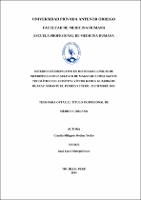Estudio retrospectivo en historias clínicas de nifedipino versus sulfato de magnesio como agente tocolítico del hospital Víctor Ramos Guardia de Huaraz durante el periodo Enero - Diciembre 2013

View/
Download
(application/pdf: 1.547Mb)
(application/pdf: 1.547Mb)
Date
2014Author(s)
Medina Yeckle, Claudia Milagros
Metadata
Show full item recordAbstract
La amenaza de Parto Prematuro es una de las patologías más peligrosas tanto para la gestante como para el producto neonatal, siendo la solución el retardo de la culminación de la gestación mediante tratamiento tocolítico y así prevenir enfermedades neonatales graves. El agente tocolítico ideal debe ser específico para la vía común del parto, fácil de administrar, económico, efectivo para prevenir el parto prematuro, y capaz de mejorar los resultados perinatales por sus menores efectos adversos maternos, fetales y neonatales
Objetivo: Comparar la eficiencia y seguridad del uso de Nifedipino versus el uso de Sulfato de Magnesio como agente tocolítico.
Método: Se trata de un estudio comparativo retrospectivo, observacional, analítico y longitudinal en historias clínicas de pacientes gestantes con diagnóstico de amenaza de parto prematuro del Hospital Víctor Ramos Guardia de Huaraz – Perú. Se analizaron 226 historias clínicas, se dividieron en 2 grupos, grupo tratado con Nifedipino (113 pacientes) y el otro con Sulfato de Magnesio (113 pacientes), tomamos los valores de inicio de efecto tocolítico y número de efectos adversos para cada grupo.
Resultados: Se encontró que de las 113 pacientes del grupo de Nifedipino, 82 respondieron o tuvieron un tiempo de inicio del efecto tocolítico menor a 20 minutos, mientras que en el grupo de Sulfato de magnesio el inicio de efecto tocolítico se produjo entre los 21 y 60 minutos, antes de los 20 minutos no se encontraron pacientes. En cuanto número de efectos adversos, se encontró que la mayoría de los pacientes el grupo tratado con Nifedipino presentaron entre 1 y 2 efectos adversos, siendo menores en cantidad comparados con el número de efectos adversos presentados en el grupo tratado con Sulfato de Magnesio, que fueron de 2 a 4 efectos adversos.
Conclusiones: El Nifedipino tiene un tiempo de inicio de efecto tocolítico menor que el Sulfato de Magnesio por lo que se considera más eficaz el uso de Nifedipino como tocolítico comparado con el uso del Sulfato de Magnesio. Además el Nifedipino tiene un número de efectos adversos menor al Sulfato de Magnesio con lo cual se demuestra que el Nifedipino es más seguro que el Sulfato de Magnesio como tocolítico. Threatened preterm labor is one of the most dangerous pathologies for the
mother or her product, been the solution to that, the delay of the gestation ending
through tocolytic treatment, so that severe neonatal diseases could be prevented.
The tocolytic agent must be specific to the common delivery way, easy to
administrate, economic, effective to prevent preterm labor, and capable of
improving the perinatal outcomes with less adverse effects to the mother, the
fetus or the newborn.
Objective: To compare efficiency and safety in the use of Nifedipine versus
Magnesium Sulfate as a tocolytic agent.
Method: This is a comparative, retrospective, observational, analytic and
longitudinal study on pregnant patient’s medical records diagnosed of threatened
preterm labor from Victor Ramos Guardia Huaraz Hospital - Peru. We analyzed
226 medical records, we divided the sample into two groups, the one treated
with Nifedipine (113 patients), and the other one treated with Magnesium
Sulphate (113 patients), we registered mother's chronological age at
presentation, mother's gestational age at presentation, onset of the tocolytic
effect, and number of adverse effects for each group
Results: We found that,.from 113 patients on the Nifepidine group: 82 respond
or had an onset time of the tocolytic effect less than 20 minutes, while in the
Magnesium Sulphate group had an onset time of the tocolytic effect between 21
and 60 minutes, plus none patients were found with less than 20 minutes. As for
the number of adverse effects on each group, the most of the patients in the
group treated with Nifedipine presented 1 or 2 adverse effects, been less in
quantity when compared to the number of adverse effects presented on the group
treated with Magnesium Sulphate, which were from 2 to 4 adverse effects.
Conclusions: Nifedipine has a shorter onset time of the tocolytic effect than
Magnesium Sulphate, ergo it is consider to be more efficient the use of
Nifedipine instead of Magnesium Sulphate as a tocolytic agent. Also, Nifedipine
has less adverse effects than Magnesium Sulphate, ergo it was demonstrated that
Nifedipine is safer than Magnesium Sulphate as a tocolytic agent.
Subject
Collections
- Medicina Humana [2969]

